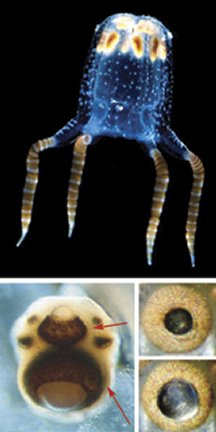Eight of the eyes on a box jellyfish have surprisingly good lenses, yet the structure of the eyes keeps them from focusing sharply, according to a new optics study.

Sharp focus may be what people and most other vertebrates want out of their lenses, but box jellyfish thrive with fine lenses and a blurry, wide picture, say Dan E. Nilsson of Lund University in Sweden and his colleagues in the May 12 Nature.
“Box jellyfish may teach us something about how the first lenses in eyes appeared,” Nilsson says.
Species of box jellyfish, so called because they look almost squared off in shape, are no passive blobs of jelly. They can swim better than a lot of other jellyfish can. Some species court their mates, and some even have internal fertilization of eggs. Typically, six eyes dot each of four movable stalks on a jellyfish, giving it a total of 24 eyes. “You can actually see them looking in your direction when you have them in the lab,” says Allen Collins of the National Oceanic and Atmospheric Administration in Washington, D.C.
Jellyfish biologists have long known that two eyes on each stalk resemble the cameralike eyes of octopuses and vertebrates. Nilsson’s team, which has analyzed eyes in other creatures, studied these eyes in the box jellyfish Tripedalia cystophora, which bob about the roots of mangrove trees in Puerto Rico. The researchers took apart the eyes and tracked the path of light through their spherical, sand-grain–size lenses.
Calculations indicate that the lenses could form almost distortionfree images. Yet the researchers found that the animal’s retinas rest in front of the plane at which this sharp focus would occur.
The resulting blurred view is good enough for spotting large objects such as mangrove roots and so “makes sense in terms of the near-shore habitats” of these creatures, says Vicki Pearse of the University of California, Santa Cruz. Other kinds of jellyfish have simpler eyes, but they tend to live in open waters without obstacles, she says.
Nilsson’s group also discovered that one of the cameralike eyes on each stalk has an iris that contracts in bright light. He says that he hadn’t expected eyes this small to have a mobile iris. Its function is unclear, he adds.
Figuring out what the box jellyfish’s 16 simpler eyes do will take some more work, Nilsson says. However, he and his colleagues propose that the box jellyfish are taking an approach to seeing that’s very different from ours. A person relies on two identical, sharp-focusing eyes to take in lots of information, which an elaborate brain then sorts out. In contrast, the box jellyfish uses several kinds of eyes that feed more-targeted types of information into the animal’s less-centralized nervous system.
This analysis of jellyfish vision provides “the strength and excitement of the paper,” says Pearse.
Biologists need to be careful in working out the evolutionary implications of the new study, says Collins. The eyes of box jellyfish, cephalopods such as the octopus, and vertebrates seem to have arisen independently. So, unraveling the evolution of box-jellyfish eyes may not reveal the particular path of eye evolution for other lineages.






